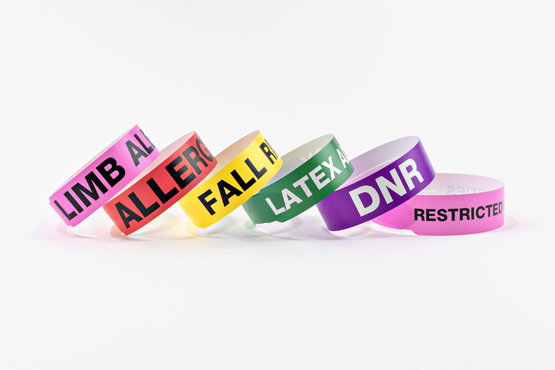Top Features to Look for in a Long-lasting Patient Identification Band
Top Features to Look for in a Long-lasting Patient Identification Band
Blog Article
Exploring the Numerous Sorts Of Patient Identification Band Used in Clinical Facilities
In the detailed world of healthcare, the important role of Patient Identification bands typically goes unnoticed. These bands, differing from basic paper wristbands to innovative RFID bands, create the backbone of Patient security procedures, making certain accuracy in Patient Identification. The substantial variety of these bands, each with its special advantages and limitations, is commonly ignored. As we browse through this topic, one may acquire insight right into the refined complexities and vital importance of such bands in medical centers.
Understanding the Importance of Patient Identification Bands
While they may appear like plain devices, Patient Identification bands play a vital function in clinical facilities. These bands act as a crucial device for confirming Patient identification, protecting against medical errors connected to misidentification. The bands typically show crucial information such as the Patient's name, age, blood group, and any type of recognized allergic reactions. They allow medical care professionals to promptly access this essential details, therefore assisting in exact and prompt medical therapy. Patient Identification bands likewise aid in enhancing management tasks, ensuring precise record-keeping and invoicing. Despite their simplicity, these bands symbolize the principle of Patient safety, a cornerstone of quality healthcare. Without them, the risk of clinical mistakes, and subsequently, Patient damage, may dramatically raise.
Conventional Paper Wristbands: Their Usage and Limitations
Conventional paper wristbands have been a staple in Patient Identification across various clinical facilities. While their usage prevails, they harbor particular constraints that may influence their performance in Patient administration. This area will concentrate on the scope of their application and the integral downsides related to their usage.
Paper Wristbands: Use Extent
In the realm of Patient Identification, paper wristbands have actually long held a vital duty. These bands are usually made use of in outpatient setups, where the Patient's keep is short-term. The wristbands consist of vital details such as the Patient's name, day of birth, and a distinct Identification number. This simple, yet efficient system, allows doctor to rapidly and properly determine people, making sure the right treatment is provided. Paper wristbands are additionally utilized in emergency circumstances, where rapid Identification is paramount. Their usage prolongs to occasions like blood contribution drives and mass vaccination programs, better emphasizing their versatility. Regardless of improvements in innovation, the modest paper wristband remains a cost-effective and reputable option for Patient Identification in various health care situations.
Limitations of Paper Wristbands
Regardless of their prevalent usage, paper wristbands are not without their downsides. Their physical resilience is among the substantial constraints. Direct exposure to water, sweat, or misuse can provide them unreadable or even cause them to break down. On top of that, paper wristbands often lack the technological capabilities of more contemporary options, such as barcoding or RFID chips, restricting their capability to just presenting composed details. The inability to update or change the information on the wristband is another drawback. Furthermore, if the information is handwritten, clarity can be jeopardized, bring about possible misidentification. Finally, paper wristbands can create pain or skin inflammation to some clients, especially when worn for extended durations.
Barcoded Wristbands: Improvements in Patient Identification
While Patient Identification has long been an essential aspect of health care, the development of barcoded wristbands symbolizes a considerable jump onward. These bands utilize the simplicity of barcoding innovation, permitting Patient info to be quickly checked and accessed. They enhance the speed and precision of Patient Identification, reducing the risk of medical mistakes connected to misidentification. Barcoded wristbands are economical, simple to generate, and eliminate handwriting errors common with hands-on systems. Nevertheless, they are not without constraints. While they provide renovations over typical bands, the barcode can become worn or smudged, making it unreadable. Regardless of this, barcoded wristbands continue to be a necessary device in modern health care setups, representing the junction of technology and Patient care.
Superhigh Frequency Identification (RFID) Bands: a Step Towards Futuristic Medical Care
The evolution of Patient Identification bands has actually produced the introduction of Superhigh frequency Identification (RFID) Bands (patient identification band). These innovative gadgets existing vital benefits for medical care facilities, providing a more effective and technically advanced ways of Patient Identification. The application of RFID in medical care is a significant action in the direction of a more futuristic method to Patient management and safety
Understanding RFID Bands

RFID Bands: Secret Benefits
Primarily, these bands improve Patient safety and security by providing accurate, instantaneous Identification, therefore lowering clinical errors. RFID bands can store a large quantity of Patient data, consisting of clinical history and allergies, making it possible for individualized treatment. Generally, RFID bands stand for a significant improvement in Patient Identification innovation, benefiting both clients and healthcare service providers.
Executing RFID in Healthcare
These bands give a seamless way to track and recognize individuals, ensuring their security and improving effectiveness in therapy procedures. RFID bands decrease clinical errors by supplying precise Patient Identification, which is essential in stopping misdiagnosis or wrong medication management. Therefore, the implementation of RFID bands is a considerable action towards enhancing Patient safety and security and healthcare shipment.

Color-Coded Wristbands: Helping in Quick and Accurate Diagnosis
In the dynamic atmosphere of a clinical center, color-coded wristbands have arised as important devices for swift and precise Identification of a person's clinical problem. These wristbands, put on by people, bring specific shades that represent different have a peek at these guys clinical conditions or statuses. Red might indicate allergic reaction risks, while yellow might symbolize her explanation a fall threat. This system is created to offer prompt visual signs to doctor, improving Patient safety and security and care high quality. In emergency scenarios, the use of these wristbands permits rapid decision-making. However, the performance of color-coded wristbands relies on the uniformity of color interpretation throughout health care institutions, requiring typical standards for constant application.
Techniques for Efficient Execution and Management of Patient ID Bands
Attaining optimum use of Patient Identification bands demands a well-structured method for their implementation and management. Patient education is additionally important; patients have to comprehend the purpose of the bands and the demand for their consistent wear. It's necessary to have a backup strategy in location, such as barcode scanning or biometrics, to ensure that Patient Identification is never ever compromised.
Verdict
Patient Identification bands are important in clinical facilities to guarantee safety and security and precision. Reliable implementation and administration of these bands can dramatically reduce visit their website medical errors, increase effectiveness, and boost total Patient treatment.
These bands, differing from simple paper wristbands to advanced RFID bands, form the backbone of Patient safety and security protocols, ensuring precision in Patient Identification.The advancement of Patient Identification bands has brought about the introduction of Radio Regularity Identification (RFID) Bands. Generally, RFID bands stand for a significant advancement in Patient Identification innovation, profiting both patients and health care service providers.
RFID bands minimize clinical errors by offering exact Patient Identification, which is vital in protecting against misdiagnosis or incorrect medicine management. Patient education is likewise important; people have to understand the function of the bands and the demand for their continuous wear.
Report this page